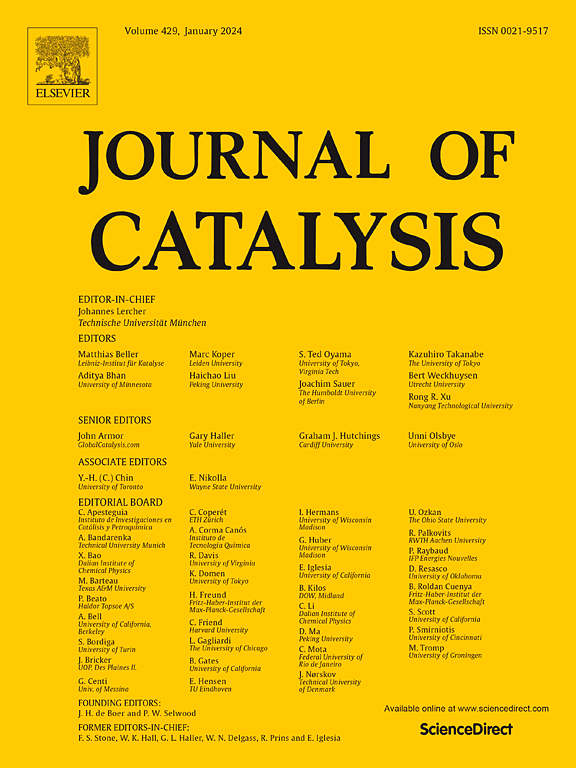串联铼-联吡啶/铜-卟啉体系协同双位点上CO2光催化转化为C2H4的计算分析
IF 6.5
1区 化学
Q2 CHEMISTRY, PHYSICAL
引用次数: 0
摘要
据报道,铼(I)-联吡啶络合物(Re-bpy)是一种非常活跃的光催化剂,可在二氧化碳还原过程中稳定*CO物种,而铜-卟啉三嗪框架Cu-PTF则是一种非常好的中继伙伴和合作者,可促进C-C偶联过程以生成C2H4。为了揭示 CO2 还原成 C1 和 C2 产物的机理,以及这两种催化剂如何协同促进 C-C 偶联,我们进行了密度泛函理论(DFT)计算。最有利的机制包括以下关键步骤:Re-bpy 活化 CO2、形成 Re - CO 物种、质子耦合电子转移 (PCET) 形成 Re - CHO 物种、Re - CHO 与 Cu - CO 协同耦合形成 Cu - CO - CHO - Re 中间体、PCET 形成静止态 Cu - CHO - CH2 - Re 中间体、另一个 PCET 生成 Cu - CHOH - CH2 - Re、PCET 和消除 H2O 并解离生成 C2H4。我们的 DFT 计算深入揭示了两种催化剂之间的催化途径和协同作用,为开发更高效的二氧化碳还原反应催化系统铺平了道路。本文章由计算机程序翻译,如有差异,请以英文原文为准。


Computational insights into the photocatalytic conversion of CO2 to C2H4 on synergistic dual sites in tandem rhenium-bipyridine/copper-porphyrinic system
The rhenium(I)-bipyridine complex (Re-bpy) has been reported to be a very active photocatalyst to stabilize the *CO species in CO2 reduction, and the copper-porphyrinic triazine framework Cu-PTF was found to be a very good relay partner and cooperator in facilitating the C−C coupling process to generate C2H4. To unravel the mechanism of reduction of CO2 to C1 and C2 products and how such two catalysts synergistically promote C−C coupling, we conducted density functional theory (DFT) calculations. The most favorable mechanism comprises the following key steps: CO2 activation by Re-bpy, formation of Re−CO species, proton-coupled electron transfer (PCET) to form Re−CHO species, synergistic coupling between Re−CHO and Cu−CO to form Cu−CO−CHO−Re intermediate, the PCET to form resting state Cu−CHO−CH2−Re intermediate, another PCET to generate Cu−CHOH−CH2−Re, PCET and elimination of H2O and dissociation to yield C2H4. Our DFT calculations provides insights into the catalytic pathways and the cooperative interactions between the two catalysts, paving the way for the development of more efficient catalytic systems for CO2 reduction reactions.
求助全文
通过发布文献求助,成功后即可免费获取论文全文。
去求助
来源期刊

Journal of Catalysis
工程技术-工程:化工
CiteScore
12.30
自引率
5.50%
发文量
447
审稿时长
31 days
期刊介绍:
The Journal of Catalysis publishes scholarly articles on both heterogeneous and homogeneous catalysis, covering a wide range of chemical transformations. These include various types of catalysis, such as those mediated by photons, plasmons, and electrons. The focus of the studies is to understand the relationship between catalytic function and the underlying chemical properties of surfaces and metal complexes.
The articles in the journal offer innovative concepts and explore the synthesis and kinetics of inorganic solids and homogeneous complexes. Furthermore, they discuss spectroscopic techniques for characterizing catalysts, investigate the interaction of probes and reacting species with catalysts, and employ theoretical methods.
The research presented in the journal should have direct relevance to the field of catalytic processes, addressing either fundamental aspects or applications of catalysis.
 求助内容:
求助内容: 应助结果提醒方式:
应助结果提醒方式:


